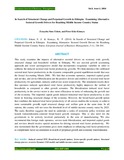| dc.contributor.author | Kimuyu, Peter K | |
| dc.contributor.author | Eshete, Zerayehu S | |
| dc.date.accessioned | 2015-03-09T12:00:44Z | |
| dc.date.available | 2015-03-09T12:00:44Z | |
| dc.date.issued | 2014 | |
| dc.identifier.citation | Eshete, S. Z. & Kimuyu, K. P (2014). In Search of Structural Change and Perpetual Growth in Ethiopia: Examining Alternative Sectoral Growth Drivers for Reaching Middle Income Country Status. European Journal of Business Management, 2 (1), 336-341. | en_US |
| dc.identifier.uri | http://hdl.handle.net/11295/81065 | |
| dc.description.abstract | This study examines the impacts of alternative sectoral drivers on economy wide growth,
structural change and household welfare in Ethiopia. We use sectoral growth accounting
approach and vector autoregressive model that incorporates exogenous variables in order to
calibrate the induced sectoral total factor productivity growths. We then introduce the calibrated
sectoral total factor productivity in the dynamic computable general equilibrium model that uses
the Social Accounting Matrix 2006. We find that economic openness, imported capital goods
and service, and service liberalization are the positive drivers and enablers of sectoral total factor
productivity for agriculture, industry and service sector respectively. The simulation results show
that openness induced agricultural total factor productivity highly improves the welfare of
households as compared to other growth scenarios. The liberalization induced total factor
productivity in the service sector is also more efficacious in terms of enhancing the growth rate
of the economy. The imported capital goods induced industrial total factor productivity is also
better in fostering structural change of the economy. However, the broad-based growth option
that combines the induced total factor productivity of all sectors enables the economy to achieve
more sustainable growth, rapid structural change and welfare gain at the same time. In all
options, the country will not cross the threshold level of middle income country status by 2025.
The study therefore suggests the need to undertake a series of economic policy revisions and
launch industrialization-centered broad-based growth strategies. This is also need for the
government to be actively involved particularly in the area of manufacturing. We also
recommend that foreign trade openness, service trade liberalization, and imported capital goods
and services should receive special attention for driving sectoral total factor productivity. We
also recommend that the government gives more emphasis to enhancing total factor productivity
to complement factor accumulation in search of perpetual growth and economic transformation. | en_US |
| dc.language.iso | en | en_US |
| dc.title | In Search of Structural Change and Perpetual Growth in Ethiopia: Examining Alternative Sectoral Growth Drivers for Reaching Middle Income Country Status | en_US |
| dc.type | Article | en_US |
| dc.type.material | en_US | en_US |


